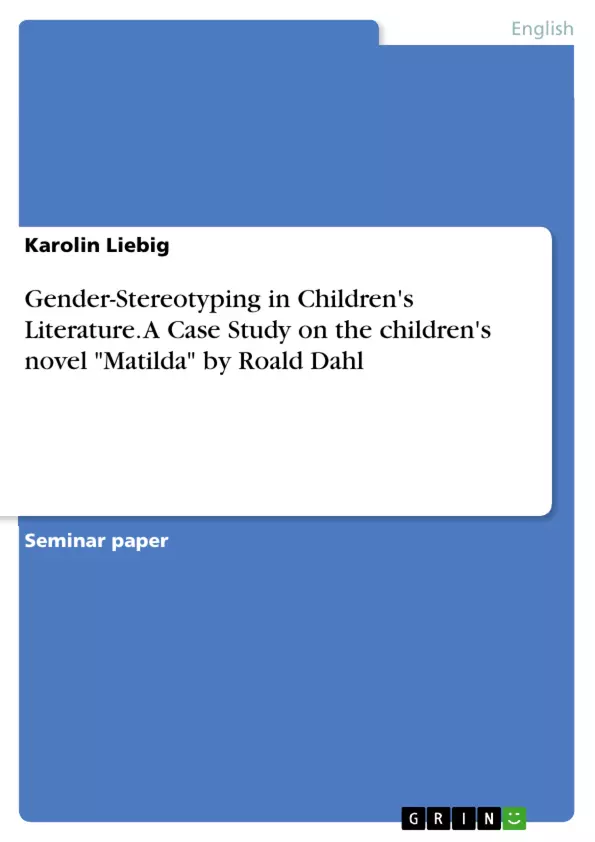This study examines the language use towards male and female characters in the children’s novel 'Matilda' written by Roald Dahl. The fact of an uneven depiction of female and male characters in children’s literature, which is proved in many studies, is the base of this analysis. With this work I examine if Dahl uses gender stereotyped language in his popular novel as well.
The selection of this book has a personal background. When I was an Au pair in Australia an audiobook with all stories of Roald Dahl fell into my hands. The owner, a boy, said I should definitely listen to those because they are “awesome”. For this kind of study I thought Matilda might be interesting because the protagonist is a girl.
The main emphasis of the analysis is put on the number of characters and their occupation, the used adjectives to describe the characters, and the verbs describing the characters’ actions. That leads to the following hypotheses:
Firstly, female characters are underrepresented in extensive roles; secondly, male characters are depicted in more different occupations than female characters; thirdly, different adjectives are used to describe female and male characters; and finally, female characters are portrayed predominantly in gender-stereotyped activities. The overall interest of this work is if the characters in this children’s novel are mainly described in a gender-stereotyped way.
My work is structured as follows: I will provide a rough introduction in Gender studies and especially in the field of Gender and Language in the first chapter. Further I point out the central matters of the research in Gender and Children’s literature and introduce a few studies that support my own examination and are the basis for the hypotheses. The first part in the second chapter gives an introduction to the sample book as well as the author.
The second point describes the procedure of the research, the consistence of the data and how it is collected. How the data is arranged for the analysis is to be found in the third part of chapter two. The third chapter starts with the analysis of the occurring characters and their occupations, followed by an analysis of the adjectives to find out if the author uses gender stereotyped words to describe female and male characters. In the fourth part of this chapter the verbs are examined for gender stereotyping female characters. The conclusion sums up the work and gives a prospect of further questions.
Inhaltsverzeichnis (Table of Contents)
- Introduction
- Literature Review
- Gender Studies - A Short Concept Explanation
- Gender and Language – A Short Concept Explanation
- The Discourse Approach
- Gender and Children's Literature
- Methodology
- Data and Sample
- Procedure
- Framework
- Results and Discussion
- The Characters
- The Occupations of the Characters
- Adjectives Describing the Characters
- The Verbs Connected to the Characters
- Biography of Author and Sample
- Conclusion
- References
- Appendix
Zielsetzung und Themenschwerpunkte (Objectives and Key Themes)
This study investigates the use of language towards male and female characters in the children's novel Matilda written by Roald Dahl, examining if the author employs gender-stereotyped language. The analysis focuses on the number of characters and their occupations, the adjectives used to describe them, and the verbs depicting their actions. The research aims to determine if the depiction of characters in the novel conforms to gender stereotypes.
- The representation of female characters in the novel.
- The portrayal of male and female characters in different occupations.
- The use of different adjectives to describe female and male characters.
- The depiction of female characters' actions through verbs.
- The overall impact of gender stereotypes on character portrayal in the novel.
Zusammenfassung der Kapitel (Chapter Summaries)
The introduction sets the context for the study by exploring the prevalent issue of gender bias in children's literature and outlining the specific focus on Roald Dahl's Matilda. It also presents the hypotheses of the research, which are subsequently examined throughout the study.
Chapter 1 provides a comprehensive review of relevant literature in Gender Studies, Gender and Language, and Gender and Children's Literature. It introduces the discourse approach, which frames the study's analysis of language and gender, and highlights key studies that support the hypotheses.
Chapter 2 delves into the methodology of the research, outlining the data and sample selection, including a discussion of the author, Roald Dahl, and the novel Matilda. This chapter also clarifies the procedures used to collect and analyze the data.
Chapter 3 presents the results of the analysis, focusing on the characters and their occupations, the adjectives used to describe them, and the verbs depicting their actions. This chapter examines the language used in the novel to determine if it aligns with or contradicts gender stereotypes.
Schlüsselwörter (Keywords)
The primary focus of this study revolves around gender studies, gender and language, gender stereotypes, children's literature, language analysis, and the analysis of Roald Dahl's novel Matilda. These key areas are explored within the framework of the discourse approach, investigating how language reflects and perpetuates gender stereotypes in children's literature.
- Citation du texte
- Karolin Liebig (Auteur), 2015, Gender-Stereotyping in Children's Literature. A Case Study on the children's novel "Matilda" by Roald Dahl, Munich, GRIN Verlag, https://www.grin.com/document/322313



